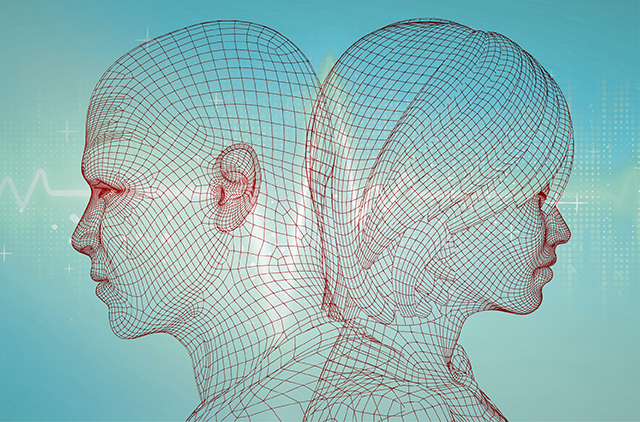HEALTH PROFILE OF THE TYPICAL UAE MAN AND WOMAN
According to the WHO, the typical UAE male will live to the age of 76. A third of the male population will suffer from some sort of health ailment, according to the UAE Men’s Health Alliance. WHO reports the most common health complaint is cardiovascular disease for both Emiratis and expatriates, according to latest statistics from the Health Authority Abu Dhabi (HAAD). Dr Charles Stanford, CEO, Burjeel Hospital, says men will get through their early years better than the average American and live to about the same age. However they are more likely to have an accidental death, especially on the roads, than average men in other developed countries. About one in four in the UAE have poor sperm quality, the most common cause of male infertility, says Bruno Rosset, a co-founder of Bourn Hall fertility clinic in Dubai.
The typical UAE woman will live two years longer than her male counterpart with an average life expectancy of 78, according to WHO. Dr Stanford says non-communicable diseases will affect female citizens in much the same way as in European and North American countries, but with their high levels of obesity there is a greater probability UAE women will develop diabetes and associated illnesses including heart disease, hypertension, stroke and kidney failure. The latest statistics made available by HAAD show expat women are most likely to die from cancer, followed by cardiovascular disease. Emirati women are more likely to die from heart disease. According to WHO’s World Health Statistics 2015 report, nearly half of UAE female residents over 18 are obese.
*******
STATE OF THE NATION'S HEALTH
With the well-being of its citizens identified as a top priority by the UAE government, the health-care sector in the country is seeing an astonishing boom in both the quality and quantity of services it provides.
The UAE’s leaders have paved the way for a rapidly expanding health-care system to meet the medical needs of Emiratis and expatriates, and a recent snapshot of the country’s health sector shows there is no sign of the market slowing down. According to the UAE Healthcare Sector Outlook 2020, RNCOS, a global business consultancy, the market is expected to grow at an average annual rate of 7 per cent over the next four years.
This follows a hospital construction boom over the past decade — characterised by a growing desire for quality health services, the need for health-care providers to catch up with a growing population, the increasing burden of chronic diseases, an ageing populace and expanding medical tourism in the region.
NUMBERS QUICKLY RISNG
The UAE population was last recorded at 9.5 million in 2014, up from 0.1 million in 1960 when the UAE’s first hospital, the Oasis Hospital in Al Ain, was built. It represents a 10,400 per cent increase over the past 50 years — in a country where about 80 per cent are expatriates.
After tackling infectious diseases over the past half century, the country is now grappling with the escalating crisis of chronic conditions and their risk factors.
Obesity is a well-known health burden and about 70 per cent of men and 67 per cent of women aged 15 years and older in the country are considered overweight.
This, in turn, has led to the mounting tide of lifestyle disorders including type 2 diabetes, hypertension and cardiovascular disease placing upward pressure on the country’s health-care system.
Dr Lalu Chacko, Chief Medical Officer for the LLH and Medeor 24x7 hospitals in Abu Dhabi, says the UAE — like all affluent societies — faces the challenges that modern societies face today.
“Sedentary lifestyles and a high intake of calorie-rich foods have caused an unprecedented surge in diabetes and heart-related problems,” he says. “Obesity in both adults and children further complicates the issue.”
Cancer is another common health problem in the UAE, he adds, while the growing number of those with allergies and airway-related diseases is also worrying.
Dr Charles Stanford, CEO of Abu Dhabi’s Burjeel Hospital, says diabetes and a lack of exercise are the biggest health concerns in the nation. “Interestingly, despite the [sunny weather], vitamin D levels are low.
Other than diseases that cause death, respiratory infections, bone and joint diseases, endocrine (including diabetes), asthma and other lung disorders and stomach and bowel disorders are all problems also common in UAE residents.”
As the country’s population ages, there is likely to be a sharp rise in demand for health care, while the UAE also has to contend with the growing needs of visitors. Plans to make the country, particularly Dubai, a hub for medical tourism have seen an influx of foreign visitors.
On the sidelines of the third International Medical Travel Exhibition and Conference (Imtec) in Dubai in October, Dr Layla Al Marzouqi, Director of Health Regulation at Dubai Health Authority (DHA), said more than a quarter of a million medical tourists visited the emirate in the first half of last year.
She expects a 12-13 per cent increase of medical tourists every year, with many coming for cosmetic treatment. With increasing demand, the UAE has been actively investing in building up and improving its national health-care system.
Led by the UAE’s main health bodies — the Health Authority Abu Dhabi (HAAD), Abu Dhabi Health Services Company, DHA and the Ministry of Health (MoH) — the country has developed an increasingly sophisticated health-care system in the more than 70 public and private hospitals and 150 plus health-care centres and clinics for citizens in the UAE.
In 2013, the DHA announced a 12-year master plan to boost health care in Dubai and turn the emirate into a hub for medical tourism — a plan that includes a Dh3-billion revamp of Rashid Hospital, 40 new primary health-care centres and three new hospitals. Schemes for more hospitals and health-care centres are also under way in Abu Dhabi and the northern emirates.
INSURING PROPER CARE
A particular focus has also been placed on ensuring all residents receive medical cover.
Abu Dhabi was the first to implement mandatory health cover in 2006 — with almost every citizen now covered under the plan.
Dubai has since followed suit and began rolling out its mandatory health insurance scheme in 2014. By mid-2016, every UAE resident will be covered. The MoH has similar plans for the northern emirates.
Another key focus has been placed on maternal and child health — both in education and the services provided. Under-five child mortality has been maintained at the low rate of one death per 1,000 children for the past decade. Investment is reaping rewards for the country’s relatively young health-care system. The UAE is ranked 27 in world health systems, according to the latest World Health Organisation (WHO) figures.
“Not everyone agrees with the methodology used since a large proportion relates to the equity of distribution rather than brilliance of some of the available facilities and services,” explains Dr Stanford. “In this report, France was number one, and the UAE 27th — ahead of both the US and Canada.”
Many factors are used to try to define health in a nation, he adds. “These include population (life expectancy, neonatal and infant mortality, birth rate), facilities (hospital beds), clinical staff (doctors, nurses, pharmacists), environment (access to clean water, housing, waste disposal), infection (immunisation, notifiable diseases), non-communicable diseases (diabetes, cardiac disease, strokes, etc.) and equitable distribution of services.”
When using these parameters, the UAE fares well, says Dr Stanford. “In the GCC, the services are among the best.”
The medical chief adds that the headway being made to tackle chronic diseases should only serve to further the UAE’s health ranking.
“The outlook for 2020 is good with better, more plentiful facilities and services as long as ageing (and its associated health problems), obesity and diabetes are addressed seriously.”
Dr Chacko says the UAE should be proud of how far its health-care system has come since the country was founded. “In a world where everything is standardised against the US and Canada, the UAE can be proud of the fact that the WHO ranks health care in the UAE higher to that of [those countries].
“The health of a nation depends on various factors — starting with the genetic make-up of its society to the social structure, cultural influences, physical environment around the population and to a large extent the availability of health-care services.
“The leaders of the countries with the foresight to build a healthy nation have devised plans and started new initiatives for a healthy UAE. Infrastructure [investment] and the health campaigns being held further prove the commitment of the government to society.”
LONG ROAD AHEAD
However, challenges remain. If demand for health care rises as experts estimate, then logic dictates that more staffing and medical expertise is needed to cope in a country that does not produce enough medical graduates and is over-reliant on recruiting staff from abroad.
A shortage of nurses and midwives persists despite a push to make the professions more attractive.
According to HAAD, the emirate is likely to need 4,800 new doctors and 13,000 new nurses by 2020. Furthermore, Dubai will need 8,000 more beds, 7,323 more doctors and 8,510 nurses in the next decade, according to Eng. Eisa Al Haj Al Maidour, Director-General of DHA.
Currently there are just 2.7 nurses and 1.5 doctors per 1,000 people. Three new medical colleges have been set up in recent years to improve this ratio, with five nursing schools planned over the coming decade to address the shortfall.
FIVE COMMON HEALTH PROBLEMS
1. Obesity
The obesity rate in the UAE is about double the world average. More than 2.1 billion people — close to 30 per cent of the global population — are overweight or obese, the World Health Organisation says.
The symptoms of obesity — caused by poor diet and an inactive lifestyle — are weight gain and a body mass index above 30. Without proper treatment, obesity can lead to serious complications including heart disease and stroke, high blood pressure, diabetes and cancer.
2. Diabetes
Recent figures from the International Diabetes Federation confirm 37 million diabetics in the Middle East and North Africa, including 803,900 in the UAE.
It predicts the region’s figure will rise by more than 80 per cent to 68 million by 2035 unless action is taken.
Type 2 diabetes — often linked to factors such as obesity and a sedentary lifestyle — accounts for about 90 per cent of cases worldwide. Left untreated, diabetes brings a heightened risk of blindness, kidney deterioration, diabetic foot and cardiovascular disease — the highest cause of death among diabetic patients.
Symptoms include excessive thirst, frequent urination, excessive hunger, blurry vision and sores or cuts that won’t heal.
3. Cardiovascular diseases
A recent survey by the Emirates Cardiac Society that quizzed more than 4,000 people found that almost nine out of ten people in the UAE are at risk of cardiovascular disease and one out of three of them are unaware of the fact.
Diabetes, hypertension, smoking, high cholesterol, obesity and a family history of cardiovascular disease are all risk factors. Heart disease and strokes are a leading killer across the world — claiming 17.3 million lives annually — and the UAE is no exception.
4. Cancer
Cancer is one of the biggest killers in the UAE with the four most common being breast, colorectal, lung and cervical cancer.
According to Health Authority Abu Dhabi (HAAD) statistics for 2014 — the most recent figures available — women accounted for 45 per cent of all cancer-related deaths, with breast cancer being the third most common cancer-related deaths for both genders, behind lung and blood cancers.
Regular screening can result in the detection and removal of precancerous growth, as well as the diagnosis of cancers at an early stage when they are most treatable.
According to HAAD, tobacco use is the most important risk factor for cancer, causing 22 per cent of global cancer deaths and 71 per cent of worldwide lung cancer deaths.
5. Mental health
Mental health has been identified as a top priority, yet stigma lingers for those who experience symptoms of depression or other psychological disorders.
“To ignore the power of the mind on health conditions and dismiss the importance of mental health is incredibly dangerous,” says Dr Deema Sihweil, Clinical Psychologist at Dubai’s Carbone Clinic.
“Developing primary prevention programmes, teaching emotional intelligence in schools and promoting the values of understanding, respect and compassion for human nature and how susceptible we all are to experiencing stress in such a diverse and fast-paced society is essential to the nation’s overall health.”













